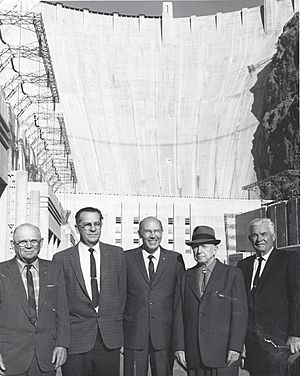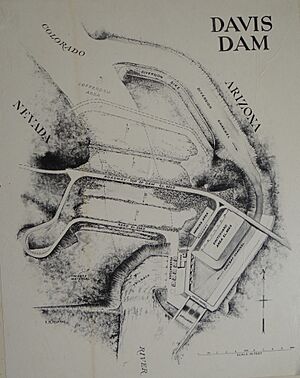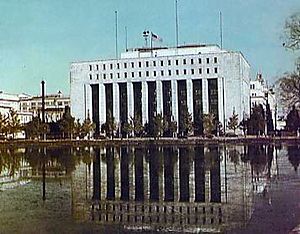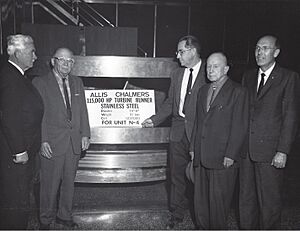Louis R. Douglass facts for kids
Quick facts for kids
Louis R. Douglass
|
|
|---|---|

Bureau of Reclamation officials at Hoover Dam (Douglass at far left) c. 1962.
|
|
| Born | March 2, 1888 |
| Died | January 13, 1979 (aged 90) |
| Occupation | Civil engineer |
| Known for | Hoover Dam and Davis Dam |
Louis Rea "Doug" Douglass (born March 2, 1888 – died January 13, 1979) was an important American civil engineer. A civil engineer designs and builds things like roads, bridges, and dams. Douglass worked for more than 20 years with the United States Bureau of Reclamation. This government agency manages water resources, especially in the western United States. He was in charge of the famous Hoover Dam and the land around it for four years.
From 1933 to 1954, Douglass worked for the Bureau of Reclamation. He helped create the construction plans for Hoover Dam and other parts of the Boulder Canyon Project. In the mid-1940s, he was an Assistant Regional Director. This meant he helped manage the Davis Dam project, which is 67 miles downstream from Hoover Dam. In 1949, he traveled to Japan. There, he studied and gave advice on how to design and build dams and irrigation systems. From 1950 to 1954, he was the Director of Power at Hoover Dam. He oversaw the installation of three new power-generating units. One of these was the first to use a special solid stainless steel turbine.
Douglass also served in the United States Army during World War I. He was part of the Quartermaster Corps. His job was to build Army hospitals in places like Leon Springs, Texas, Baltimore, Maryland, and Detroit, Michigan. After his Army service, he worked as the City Engineer in Henderson, Nevada, for three years in the 1950s. He also led the Colorado River Advisory Board.
Contents
Early Life and Education
Louis Douglass was born in 1888 in what was then called The Territory of The Indian Nations. This area later became Gallup, New Mexico. People said Douglass was very proud of his family's history as pioneers. He often talked about the useful skills he learned growing up on the frontier. Douglass went to the University of Colorado at Boulder. There, he earned two degrees in civil engineering.
Engineering Career Highlights
Douglass started his engineering career in 1909. He worked for a company called Danford & Sanderson in Colorado. He quickly became a junior partner in the firm.
World War I Service
On May 17, 1917, the United States joined World War I. Soon after, Douglass joined the United States Army. He became a captain in the Quartermaster Corps. This part of the Army handles supplies and construction. At first, he was in charge of building sewers and army camps in Leon Springs, Texas. Later, he supervised the building of Army hospitals. These hospitals were in Leon Springs, Baltimore, Maryland, and Detroit, Michigan. He left the Army in June 1919.
Post-War Engineering
After World War I, Douglass moved to Dearborn, Michigan. He worked as an engineer for a company connected to the Ford Motor Company. Later, he started his own engineering company. It was called Douglass, Corey and Fish Engineers. They had offices in Colorado.
In 1933, Douglass was hired by the United States Bureau of Reclamation. He joined their civil engineering team in Denver. At this time, the huge Hoover Dam was being built. Douglass was assigned to create the construction drawings for the Hoover Dam Project. He worked for the Bureau of Reclamation for over 20 years. He retired in 1954. From 1950 to 1954, Douglass was in charge of Hoover Dam and the park land around it.

One of Douglass's projects was designing the roof for the Bureau of Reclamation's power house. This building was part of a hydroelectric project near Boulder City, Nevada. The roof was specially designed to be strong enough to withstand large rocks that might fall from the nearby cliffs. In 1939, he wrote a paper about how to prevent accidents on large construction projects for the Bureau of Reclamation.
Leadership Roles
In February 1944, Douglass moved to Washington, D.C.. He became an Engineering Assistant to the Commissioner of the U.S. Bureau of Reclamation. This was a very important role.
In October 1944, he was sent to Boulder City, Nevada. He became the Assistant Regional Director for the Bureau's new Region III. During this time, Douglass had a lot of responsibility for the Davis Dam project. This dam was being built 67 miles downstream from Hoover Dam. He was known as an expert on the Davis Dam and its surrounding area.

At the end of 1948, Douglass went to Japan. He worked as an advisor for the general headquarters of the Supreme Commander for the Allied Powers in Japan. This group was led by General Douglas MacArthur. Douglass studied and made suggestions for designing and building dams and irrigation systems in Japan. He received an award for his excellent work there.
In 1950, Douglass became the Director of Power at Hoover Dam. In this role, he managed the installation of three new power-generating units. These were units A-3, A-4, and A-9, located in the Arizona part of the power plant. The A-9 unit was special because it was the first at Hoover Dam to have a solid stainless steel turbine. Douglass retired from the Bureau in 1954. When he retired, he received a special award called the United States Department of the Interior Distinguished Service Citation and Gold Medal. This award recognized his great work in water conservation and control.
After retiring from the Bureau, Douglass worked for three years as the City Engineer in Henderson, Nevada. He also served as the Chairman of the Colorado River Advisory Board.
Family and Community Service
Louis Douglass was married to Amelia Fredericka Hindman. They had a son, Frederick, and a daughter, Florence Elizabeth. Sadly, his first wife passed away in 1919. Douglass later married Norma Douglass in August 1922.
He was a member of several community groups. These included the Masonic Order, Rotary International, and the American Legion. He was also part of professional engineering groups like the American Society of Civil Engineers. He was a past president of the local Rotary Club and the Boulder City Shrine Club. Douglass was also the District Chairman for the Boy Scouts of America in the Boulder Dam area. He served as president of the Board of Boulder City Hospital for six years. He was also a member of the Boulder City School Board in the 1950s.
Douglass was a member of St. Christopher's Episcopal Church in Boulder City. He helped lead the church from 1955 to 1960. After he retired, he built beautiful wooden items for the church. These included a mahogany pulpit, a lectern, a prayer desk, and a baptismal font.
Douglass was also a popular speaker in the Boulder City area. He was known as a great storyteller. People said he could always tell a good story for any occasion.
In his later years, Douglass and his wife lived at the Boulder City Care Center. He passed away in Boulder City in 1979 at the age of 90. He was buried in Trinidad, Colorado.


